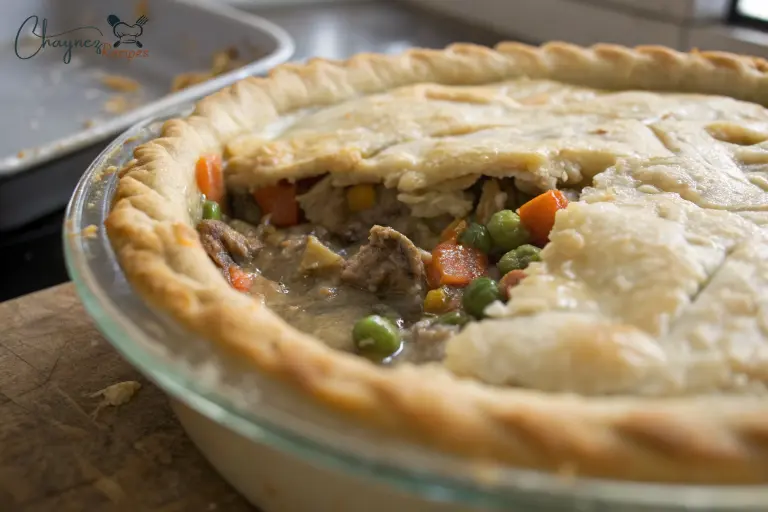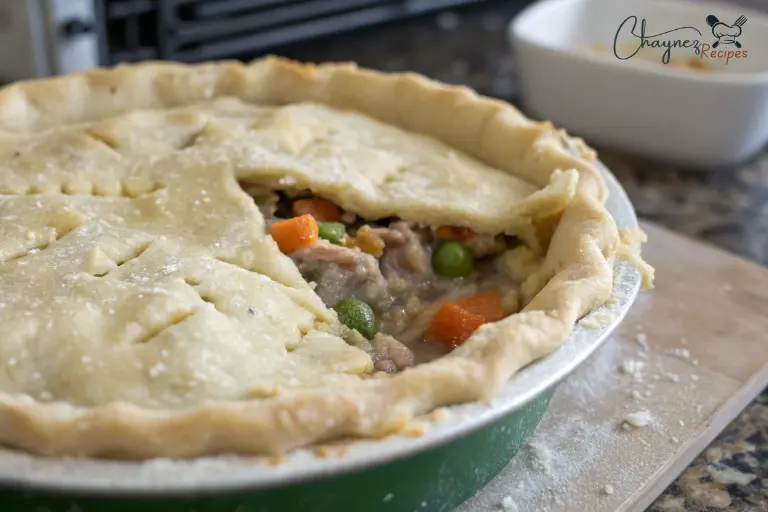Pot pies are a beloved comfort food, combining a delicious, savory filling with a golden, flaky crust. But if you’ve ever pulled a pot pie out of the oven only to discover that the bottom of your pot pie is soggy, you’re not alone. The soggy bottom of a pot pie is a frustrating problem that many home cooks encounter. So, why is the bottom of your pot pie soggy, and how can you fix it? In this article, we’ll explore the main reasons behind this issue and share practical tips to prevent it, ensuring your pot pie comes out with a perfectly crisp bottom every time.
When baking a pot pie, the challenge lies in maintaining the balance between a hearty filling and a crust that stays crisp and flaky. If you’ve ever wondered, “Why is the bottom of my pot pie soggy?”, it often comes down to moisture and improper techniques. Fortunately, by addressing the common causes of soggy bottoms and following the solutions provided here, you can enjoy a beautifully cooked pot pie with a perfect crust. Let’s get into the details of why this happens and how to avoid it in the future.
By the end of this article, you’ll be well-equipped with the knowledge to answer the question: Why is the bottom of my pot pie soggy? and how to ensure that your next pot pie turns out perfectly!
Understanding the Pot Pie Structure
A pot pie is a savory dish typically made of a filling that includes meat, vegetables, and gravy, all encased in a pie crust. While the top of the pot pie often turns golden and crispy, the bottom is prone to becoming soggy if not prepared properly. The key to a perfect pot pie lies in managing the moisture in the filling and ensuring the crust is baked evenly.
What Causes a Soggy Bottom?
The primary reason for a soggy bottom in a pot pie is excess moisture. Pot pie fillings, especially those with gravy or broth, release liquid as they cook. If the crust absorbs too much of this moisture, it will become soft and soggy rather than crispy. Let’s break down the most common causes.
1. Too Much Liquid in the Filling
One of the main culprits behind a soggy pot pie is an overly liquid filling. Gravy, broth, and even the natural juices from vegetables and meat can release a significant amount of liquid during cooking. If the filling isn’t thickened properly before placing it in the pie crust, the moisture can seep into the bottom, ruining the crust.
How to Fix It:
- Thicken the Filling: Use a roux (flour and butter mixture) or cornstarch to thicken the filling. This will help absorb excess moisture and prevent it from making the crust soggy.
- Cook the Filling to Reduce Moisture: Before filling the pie crust, cook the filling on the stove until it’s thickened and any excess liquid evaporates. This step ensures that the filling isn’t too watery.
2. Unbaked Bottom Crust
Another reason for a soggy bottom could be an unbaked crust. If you simply add the filling to an unbaked bottom crust and place it in the oven, the moisture from the filling will soak into the dough before it has a chance to crisp up.
How to Fix It:
- Prebake the Bottom Crust (Blind Baking): Prebake the bottom crust for 10-15 minutes before adding the filling. This allows the crust to set and forms a barrier between the liquid filling and the dough.
- Use Pie Weights: When blind baking, use pie weights or dried beans to weigh down the crust. This prevents it from puffing up during baking and ensures an even bake.

3. Using a Weak Pie Crust
Not all pie crusts are created equal. If you’re using a crust that is too thin or made with low-quality ingredients, it may not be able to withstand the moisture from the filling. Additionally, homemade pie crusts that haven’t been chilled properly can become too soft and fall apart when baking.
How to Fix It:
- Make a Sturdier Pie Crust: Use a pie crust recipe that includes the right ratio of fat (butter, shortening, or lard) and flour. The fat helps create a flaky, crispy texture, while the flour provides structure.
- Chill the Dough: After preparing the dough, chill it in the fridge for at least 30 minutes before rolling it out. This helps the crust maintain its shape and reduces the risk of sogginess.
4. Improper Oven Temperature
If your oven is too cool, your pot pie will take longer to cook, causing the filling to release more moisture and the bottom crust to become soggy. On the other hand, if the oven is too hot, the top of the pie may burn before the bottom has a chance to cook properly.
How to Fix It:
- Preheat the Oven: Always preheat your oven to the correct temperature before placing the pot pie inside. For most pot pies, a temperature between 375°F and 400°F (190°C-200°C) is ideal for achieving a crispy crust.
- Use a Baking Sheet: Place your pot pie on a baking sheet to catch any drips and allow for even heat distribution. This ensures that the bottom bakes evenly.
5. Overcrowding the Filling
If you pack too much filling into the pot pie, there won’t be enough room for the crust to bake properly. Additionally, the extra filling can cause more liquid to be released, further contributing to the soggy bottom issue.
How to Fix It:
- Don’t Overfill the Pie: Make sure to leave about half an inch of space between the top of the filling and the edge of the crust. This allows the heat to circulate and ensures the crust has enough space to cook properly.
6. Adding Wet Vegetables
Certain vegetables, such as mushrooms, tomatoes, and zucchini, release a lot of moisture during cooking. If these vegetables are added directly to the pot pie without being properly prepared, they can make the bottom crust soggy.
How to Fix It:
- Pre-cook Moisture-Rich Vegetables: To avoid excess moisture, sauté or roast vegetables that release water before adding them to the filling. This helps to evaporate the liquid and prevent it from soaking into the crust.
7. Using a Pie Dish with a Dark or Non-stick Surface
Dark-colored or non-stick pie dishes tend to absorb more heat, which can cause the crust to cook too quickly on the outside while remaining soggy on the bottom. The uneven heat distribution may not allow the crust to cook properly.
How to Fix It:
- Use a Light-Colored Pie Dish: A light-colored ceramic or glass pie dish will allow for more even heat distribution, resulting in a better-baked bottom crust.
- Check the Heat Source: If you’re using a dark-colored dish, consider lowering the oven temperature slightly to prevent burning the top before the bottom is cooked through.
8. Not Letting the Pot Pie Rest After Baking
Allowing the pot pie to rest for a few minutes after baking may seem unnecessary, but it’s an important step. When you remove the pie from the oven, the filling continues to release steam, which can make the bottom crust soggy if you slice it immediately.
How to Fix It:
- Let the Pie Rest: Allow the pot pie to rest for about 10-15 minutes before serving. This gives the filling time to set, preventing excess moisture from escaping and soaking the crust.

FAQs: Why is the bottom of my pot pie soggy?
1. Why is the bottom of my pot pie soggy despite using a thick filling?
The sogginess might be due to excess moisture in the filling, even if it’s thickened. It’s important to cook the filling until the liquid evaporates before adding it to the crust.
2. Can I prevent a soggy bottom by blind baking the crust?
Yes, prebaking (blind baking) the bottom crust helps it set and creates a barrier that prevents moisture from soaking in, resulting in a crispier bottom.
3. Does using too much liquid in the filling make the bottom soggy?
Absolutely. If there’s too much liquid in the filling, it will seep into the crust, causing it to become soggy. Reduce the liquid or thicken the filling before adding it.
4. Should I use a specific type of pie dish to avoid a soggy bottom?
Yes, a light-colored ceramic or glass pie dish works best. Dark-colored or non-stick pans absorb heat unevenly, which can result in a soggy bottom.
5. How long should I let my pot pie rest to avoid a soggy bottom?
Let your pot pie rest for about 10-15 minutes after baking. This allows the filling to set and prevents excess moisture from making the crust soggy.
Conclusion: Why is the bottom of my pot pie soggy?
Now that we’ve tackled the question, “Why is the bottom of my pot pie soggy?”, you’re equipped with all the tips and tricks to ensure a perfectly crispy crust every time. By understanding the causes of a soggy bottom, such as excess moisture in the filling, unbaked crusts, or overcrowding the dish, you can take proactive steps to achieve that golden, flaky result. Whether it’s prebaking the crust, thickening your filling, or making sure your oven temperature is just right, these solutions will help elevate your pot pie game. So go ahead and give them a try the next time you’re making your favorite pot pie recipe!
If you love comfort food as much as pot pie, why not try other hearty dishes that are just as satisfying? For example, our Alfredo Chicken Noodle Soup is a creamy, delicious bowl of comfort, perfect for chilly days. Or try ourSteak Alfredo Recipe for a rich and flavorful meal. For a twist on classic soup, check out our Chicken Alfredo Soup with Beef and Parmesan Cheese. These recipes are sure to delight your taste buds while offering more opportunities to practice your cooking skills and avoid any soggy situations!
Don’t miss out on more great ideas for healthier baking and cooking. For additional tips, recipes, and updates, follow us on Chaynez Recipes to access our latest posts and social media links.






